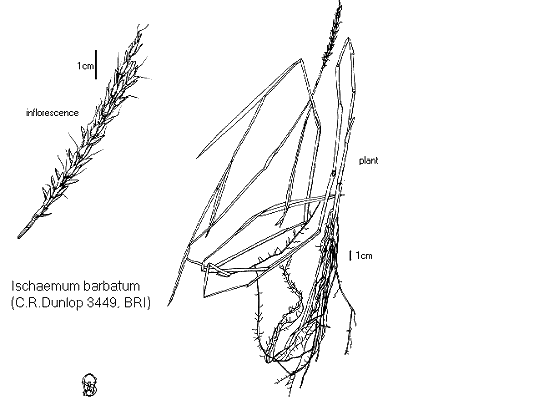 |
 |
|
 |
 |
|

Ischaemum barbatum Retz.
|
Derivation
Ischaemum L., Sp. Pl. 1: 1049 (1753); Gen. Pl. 5th edn,
469 (1754); from the Greek ischo (to restrain) and haima (blood),
as woolly seeds of the type species were reported as being used to stop bleeding.
barbatum- Latin for bearded or barbed. With hairs on the callus, glumes or lemma.
Published in
Observ. Bot. 6: 35 (1791).
Habit
Perennial. Culms erect or geniculately ascending, 60–160 cm tall. Mid-culm
nodes glabrous. Lateral branches simple. Ligule an eciliate membrane, 2–3.5
mm long. Leaf-blades 7–20 cm long, 4–10 mm wide.
Inflorescence
Inflorescence with ramose branches. Rames single or paired, 5–9 cm long.
Rhachis fragile at the nodes, angular, ciliate on margins. Rame internodes columnar,
4–5 mm long, flat and forming a U or V shape with the pedicel in rear view.
Rame internode tip transverse, cupiliform.
Spikelets
Spikelets in pairs, one sessile and fertile and the other (companion) spikelet
pedicelled. Pedicels columnar, 1–2 mm long, ciliate. Companion spikelets
developed, sterile, comprising 2 subequal glumes without lemmas or containing
empty lemmas or male, asymmetrical, oblong, 4–6 mm long, as long as fertile,
separately deciduous. Companion spikelet glumes chartaceous, winged on keels,
muticous. Companion spikelet lemmas 2, enclosed by glumes, muticous. Fertile
spikelets 2-flowered, comprising 1 fertile floret, lower floret male, upper
fertile, without rhachilla extension, elliptic or oblong, dorsally compressed,
5.5–8 mm long, falling entire, deciduous with accessory branch structures.
Spikelet callus square, glabrous or pubescent, base truncate, inserted.
Glumes
Glumes dissimilar, firmer than fertile lemma. Lower glume oblong, asymmetrical,
100% of length of spikelet, membranous or coriaceous or indurate, much thinner
above, 2-keeled, keeled laterally, narrowly winged on keel, winged near apex
or above, 13–15-nerved. Lower glume lateral nerves obscure. Lower glume
surface convex. Lower glume surface muricate or rugose, rough below or on flanks.
Lower glume apex acute. Upper glume lanceolate, 5–7 mm long, coriaceous,
much thinner above, 1-keeled, 3-nerved. Upper glume surface glabrous. Upper
glume margins ciliate. Upper glume apex acute or acuminate.
Florets
Basal sterile floret 1, with palea. Lemma of lower sterile floret lanceolate,
4–6 mm long, 75% of length of spikelet, hyaline or membranous, 3-nerved,
acute. Fertile lemma linear or oblong, 4–5 mm long, membranous, 3-nerved.
Lemma apex lobed, 2-fid, with linear lobes, incised 25–75% of lemma
length, 1-awned. Median (principal) awn from a sinus, geniculate, 9–15
mm long overall, with a twisted column. Column glabrous. Palea linear, 4–5
mm long, 100% of length of lemma. Grain 1 mm long.
Continental Distribution:
Africa, Temperate Asia, Tropical Asia, Australasia.
Australian Distribution:
Northern Territory: Darwin & Gulf.
Classification. (GPWG
2001):
Panicoideae: Andropogoneae
Notes
Native.

Habit and inflorescence (line drawing)
© Queensland Herbarium
by Will Smith